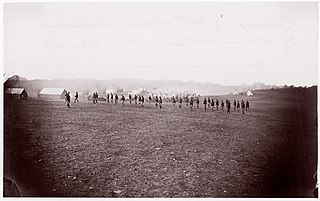The 11th Maine Infantry Regiment was an infantry regiment that served in the Union Army during the American Civil War.
The 67th Ohio Infantry Regiment was an infantry regiment in the Union Army during the American Civil War.
The 132nd Ohio Infantry Regiment, sometimes 132nd Ohio Volunteer Infantry was an infantry regiment in the Union Army during the American Civil War.
The 133rd Ohio Infantry Regiment, sometimes 133rd Ohio Volunteer Infantry was an infantry regiment in the Union Army during the American Civil War.
The 134th Ohio Infantry Regiment, sometimes 134th Ohio Volunteer Infantry was an infantry regiment in the Union Army during the American Civil War.
The 138th Ohio Infantry Regiment, sometimes 138th Ohio Volunteer Infantry was an infantry regiment in the Union Army during the American Civil War.
The 143rd Ohio Infantry Regiment, sometimes 143rd Ohio Volunteer Infantry was an infantry regiment in the Union Army during the American Civil War.
The 163rd Ohio Infantry Regiment, sometimes 163rd Ohio Volunteer Infantry was an infantry regiment in the Union Army during the American Civil War.
The 13th New Hampshire Infantry Regiment was an infantry regiment that served in the Union Army during the American Civil War. This regiment had the distinction of having the first U.S. flags in the city of Richmond, Virginia, on April 3, 1865.
The 18th New Hampshire Infantry Regiment was an infantry regiment that served in the Union Army during the American Civil War.
The 11th Connecticut Infantry Regiment was an infantry regiment that served in the Union Army during the American Civil War.

The 97th Pennsylvania Infantry was a Union infantry regiment which fought in multiple key engagements of the American Civil War, including the Siege of Fort Pulaski, Bermuda Hundred Campaign, Battle of Cold Harbor, Siege of Petersburg, and the Carolinas Campaign.
The 40th Regiment, Massachusetts Volunteer Infantry Regiment was a three-year infantry regiment of the Union Army that served in the Department of Virginia and North Carolina, the Army of the Potomac, and the Department of the South during the American Civil War.

The 34th Regiment Massachusetts Volunteer Infantry was an infantry regiment that served in the Union Army during the American Civil War.

The 10th United States Colored Infantry was an infantry regiment that served in the Union Army during the American Civil War. The regiment was composed of African American enlisted men commanded by white officers and was authorized by the Bureau of Colored Troops which was created by the United States War Department on May 22, 1863.
The 19th United States Colored Infantry was an infantry regiment that served in the Union Army during the American Civil War. The regiment was composed of African American enlisted men, mostly from southern Maryland and that state's Eastern Shore. Commanded by white officers, it was authorized by the Bureau of Colored Troops which was created by the United States War Department on May 22, 1863.

The 22nd United States Colored Infantry was an infantry regiment that served in the Union Army during the American Civil War. The regiment was composed of African American enlisted men commanded by white officers and was authorized by the Bureau of Colored Troops, which was created by the United States War Department on May 22, 1863.

The 211th Regiment Pennsylvania Volunteer Infantry was an infantry regiment of the Union Army in the American Civil War. Raised in western Pennsylvania in September 1864, the regiment initially served with the Army of the James during the Siege of Petersburg, holding trenches at Bermuda Hundred. In late November it transferred to the Army of the Potomac and during the northern hemisphere spring campaign fought in the counterattack during the Battle of Fort Stedman and the Union breakthrough at Petersburg. During the last days of the Appomattox Campaign it guarded trains, and participated in the Grand Review of the Armies following the end of the war before mustering out.

The 199th Regiment Pennsylvania Volunteer Infantry, alternately known as the Commercial Regiment, was an infantry regiment of the Union Army in the American Civil War. Raised in Philadelphia in late 1864, the regiment enlisted for one year and was sent to the Army of the James during the Siege of Petersburg. During the Third Battle of Petersburg it assaulted Forts Gregg and Alexander, then pursued the retreating Confederate Army of Northern Virginia, fighting at Rice's Station and Appomattox Court House. Following the Confederate surrender at Appomattox, the regiment moved to Richmond, where it mustered out in late June 1865.

The 207th Regiment Pennsylvania Volunteer Infantry was an infantry regiment of the Union Army in the American Civil War. Raised mostly in northern and central Pennsylvania in mid-1864, the regiment initially served with the Army of the James during the Siege of Petersburg, holding trenches at Bermuda Hundred. In late November it transferred to the Army of the Potomac and during the northern hemisphere spring campaign fought in the counterattack during the Battle of Fort Stedman and the Union breakthrough at Petersburg. During last days of the Appomattox Campaign it guarded the supply line, and participated in the Grand Review of the Armies following the end of the war before mustering out.






